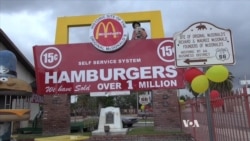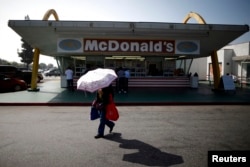Fast-food giants are facing demanding customers who want healthful food that can be tailored to individual tastes. These days, they want something more than just hamburgers and french fries.
In the industry's infancy, though, that alone was the perfect combination.
Fast food got its start on historic Route 66 in San Bernardino, California, where the McDonald brothers opened a restaurant in 1940. They would later streamline their operation to focus on burgers and fries, sold at high volume and for a low price. A business acquaintance named Ray Kroc helped them expand their franchise and later bought them out, and he created a worldwide empire.
A privately run museum on the site of that first McDonald's celebrated the company's 75th anniversary, as museum owner Albert Okura told visitors about the brothers' big idea.
“They had hamburgers and french fries, meat and potatoes," he said. "They had the right food at the right time in the history of America.”
It was fast and it was cheap. Tommy Bliss came often in those early days, when the restaurant was a popular hangout for the local teenagers.
“Well, you know, all the hot girls were hanging around McDonald's then, and all the hot cars were cruising around it,” he said.
Different appeal
Young people are likely to hang out at other restaurants today, like Chipotle. The growing Mexican-food chain advertises its healthful ingredients. A Chipotle outlet in Washington draws customers like Yao Odamtten.
“I just eat healthy and I like health and wellness. It's very important to me,” he said.
Chipotle is part of a new segment of “fast-casual” restaurants, said industry analyst Shon Hiatt of the University of Southern California.
What makes restaurants like Chipotle, Panera and Noodles & Company different from fast food "is that the food is tailored, and it can be customized," he said. "It's still quick, and also has this perception of being much higher quality.”
Burgers made with Angus beef, with or without tomato, or a vegetarian sandwich with Portobello mushrooms — that's the formula of Shake Shack, a New York hot dog-and-burger joint that had its initial public offering this year.
Hiatt said these new chains cater to Millennials, young people who became adults around the year 2000.
“Recent statistics over the last four years have shown that Millennials, on average, have been increasing their consumption of fast casual by 5 percent annually, whereas their consumption of fast food has remained largely flat,” he said.
Falling profits, image trouble
McDonald's is facing falling profits and is coping with fallout of news last year that its Chinese supplier had provided the company with expired meat. The scandal also tarnished Yum Brands outlets such as KFC.
McDonald's has diversified its menu to include more healthful items. It is also exploring automation to make its food more customizable.
And in the face of worker demands for higher wages, the company may use automation to reduce its labor costs. Industry analysts say the fast-food giants need to innovate to keep pace with a changing business landscape and changing tastes.
VOA's Steve Baragona contributed to this report.








